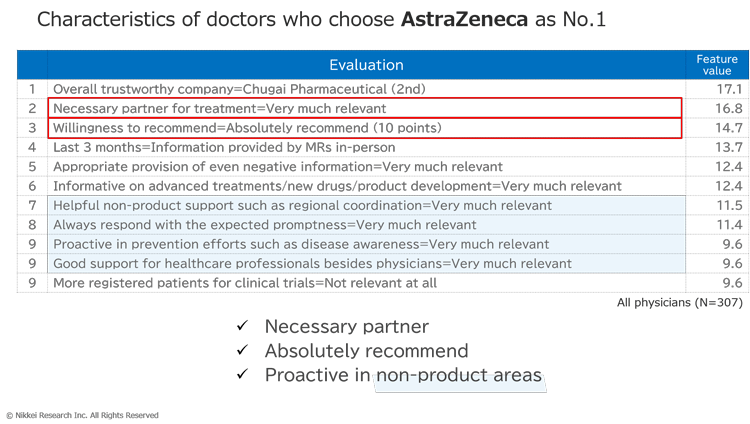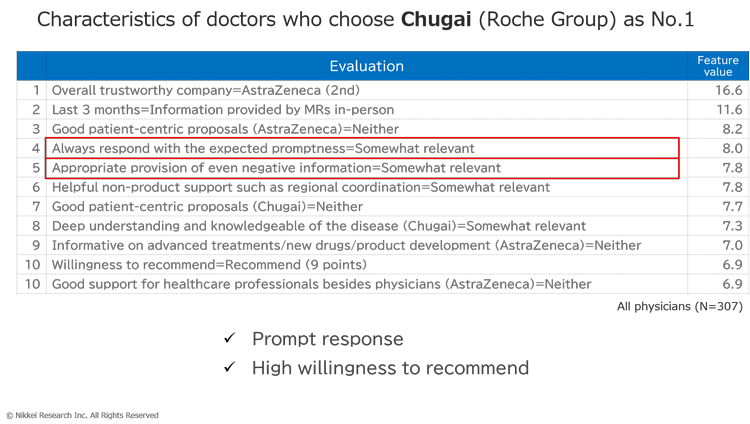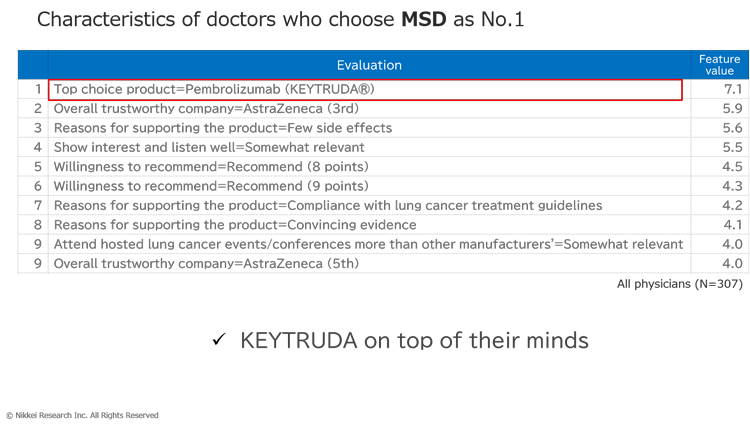The Changing Pharmaceutical Industry: (3) How to Improve the Physician Engagement
Michie Komoto, Healthcare Research Team
In this three-part series, we will discuss physician engagement. First, we will review customer engagement in the pharmaceutical industry today, which incorporates a wide range of data. Next, we will dive into the results from our survey on pharmaceutical companies’ ratings, specifically around lung cancer, and explore the differences between companies. Lastly, we will explain an approach to improve physician engagement with healthcare research.
(3) How to improve physician engagement
Exploring the doctor’s mindset in choosing pharmaceutical companies by data mining
For deep diving into understanding the differences in pharmaceutical companies' ratings by physicians, we carried out a unique analysis with our proprietary data mining tool — KeyExplorer.

The KeyExplorer can handle both numerical and text data, such as responses to open-ended questions, and uncovers the characteristics of certain segments. The beauty of this method is that it allows us to gain data-driven results quickly. We don’t need to go through tons of cross-tabulations by the human eye anymore, and also, we can eliminate self-righteousness. The tool outputs the ranking of feature strengths. The feature strength represents the strongest characteristics that stand out from other segments in comparison.
Doctors whose top choice is AstraZeneca tend to perceive the company as a necessary partner for treatment and show a strong willingness to promote it to others. Many companies in the top 10 list are highly rated on their support not related to the products.

Chugai Pharmaceutical (Roche Group) is also rated high, with many doctors ranking it as the 2nd after AstraZeneca. While having rated high in promoting to others, they are recognized with good performances of MRs (medical representatives), such as in quick response and provision of appropriate information, down to even the negative ones. In addition, it seems that doctors who do not have strong support for AstraZeneca, tend to have Chugai as their top choice.

MSD, which is also highly rated in promoting to others, has unique characteristics, different from AstraZeneca and Chugai (Roche Group), with a strong performance in product-related areas. The results show clearly that doctors who choose MSD as their top choice have KEYTRUDA® (pembrolizumab) on their minds. In other words, there are not many other characteristics.

Summary of the analysis
The table below is the summary of the characteristics and challenges of the top 3 pharmaceutical companies, derived from the analysis run by KeyExplorer.
| Characteristics | Challenges | |
|---|---|---|
| AstraZeneca |
|
|
| Chugai (Roche Group) |
|
|
| MSD |
|
|
Harnessing research and analysis
By adding external data, such as physician’s ratings, with internal data, we can specify the needs and situation to build a better engagement. This can be done in a three-step approach.
| Step 1 | Quantitative research for evaluation. Carefully look at the challenges to overcome, clarify the survey objectives, and design the most suitable survey. |
|---|---|
| Step 2 | Qualitative research and interviews for further understanding and for exploring root causes. Effective when interviewing not only target segments but also internal people and partners. |
| Step 3 | A scheme for making the best of the research outcomes. For example, holding workshops to understand fully the survey results and organize challenges. “Doing a survey is not the goal!” |
The areas to focus on would most likely differ from manufacturers of branded drugs to generic drug manufacturers. It will also be different between product and non-product or between before/after launch in the product development process. Beyond the product itself, we can also focus on support, usage behavior, evaluation of tools, non-product initiatives, corporate, and branding, etc. In terms of generic drugs, other than quality, trust, and supply, sales and human factors such as the response of MR and MS affects the corporate and brand’s reputation more than branded drugs.
We believe that these topics can be covered in carefully tailored research and data analysis.
please contact us below.

